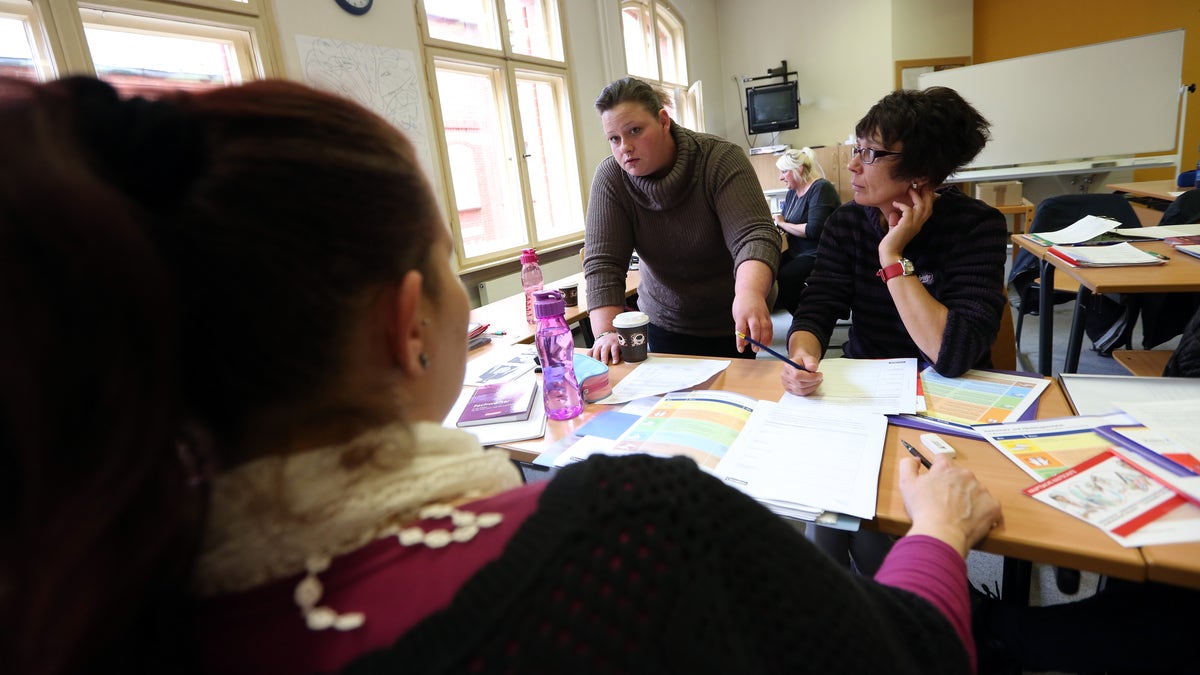
BERLIN, GERMANY - MAY 14: Students go over a lesson during an elderly care training program at the Edith Stein Catholic vocational training center on May 14, 2014 in Berlin, Germany. The supply of caregivers for the elderly in Germany has not met the demand, as an aging population finds itself in need of qualified nurses. According to one study, estimates hold that there will be a shortage of up to 152,000 caregivers by the year 2025. Due to low fertility rates and increased longevity, the elderly population of the country is predicted to increase from 7% of the total population in the previous century to over 10% by the year 2020. (Photo by Adam Berry/Getty Images) (2014 Getty Images)
Diana Gomez was a first generation Latina student attending college, 45 minutes from home. Her parents supported her emotional desire to attend college, but could not, financially. Diana went to school full time, but also worked three jobs as a nanny, student assistant and clinical tech to make it work.
Diana, like many Hispanic female students, faced what seemed conflicting messages from her parents. They supported her dreams of a college degree, but they also needed her at home to help raise her younger siblings, help clean the house, run errands for the family. Diana struggled her first year of college trying to establish herself academically and develop new friendships while running home every weekend to keep up her family’s expectations at home.
Improving the Latinas’ success rate in college enrollment and graduation benefits not only this particular portion of society, but also creates a better educated population who can make strong, positive contributions to the economy and to the cultural fabric of the society.
It was the summer before her sophomore year that Diana made a very difficult, but brave choice to tell her parents she would not be able to come home as frequently and she made herself and her classes the priority. Though Diana felt the decision was right, it did come with feelings of guilt. Family was so important to Diana, but she knew she would fail if she continued the path she was on.
Diana’s story is typical of what many Latinas face while attending college. It’s no wonder that Hispanic females are not graduating college at the same rate (43 percent) as all other women (52.3 percent), even though Hispanics are the largest ethnic minority in the United States.
Going to college is hard enough. With these additional barriers – responsibilities at home, gender role socialization, lack of financial support, lack of role models and mentors, and being first generation college students - perhaps it is not surprising that this population struggles, more than any other, during the first year of college.
Latino children make up a majority of Texas public school students. The Hispanic population is the only ethnic group projected to increase in elementary and secondary Texas schools from 40 percent in 2000 to 66 percent in 2040, a 26 percent increase.
The Texas population is now 38 percent Hispanic, up 6 percent since 2000, and will be the largest population group by 2020. The problem of low participation of Hispanics in both secondary and higher education will likely become more acute.
Hispanic students are overrepresented in high school dropout rates (49 percent) and underrepresented in graduation rates (7 percent) in higher education. To the extent that college attrition remains unaddressed for this population, there is a potential of jeopardizing individual well-being, as well as the social and economic future of Texas.
As a society, we have to find ways to be more proactive to help ensure the success of Latinas in college. Colleges and universities should offer information sessions about college to parents (in English and Spanish) so more realistic expectations can be established early on.
They should provide various support programs in college that will provide a support network for Latinas as they navigate through their college experience. Providing Latinas with connections to campus resources and periodically checking in with them throughout the semester will help ensure that their experiences are matching their expectations and would provide a time to readjust those expectations if they are misaligned.
It is critical for colleges and universities to better understand what the expectations are and reflect on how the institution’s actions can demystify or reinforce these expectations and put into place policies and programs to better bridge that potential gap.
After a student enrolls in higher education, retaining that student through graduation should be the goal of higher education. Enrollment in higher education is not equivocal to obtaining a degree, but presents only the opportunity to obtain a degree. We have a social obligation to do all that we can to ensure that Latina students who have been accepted and made the commitment to come to college have every opportunity to succeed. Improving the Latinas’ success rate in college enrollment and graduation benefits not only this particular portion of society, but also creates a better educated population who can make strong, positive contributions to the economy and to the cultural fabric of the society.
With support from her university, Diana joined a Latina sorority and latched on to two Latina advisors of another student organization that helped provide support of the experiences she was facing. Through her brave choices, developing a strong network and finding mentors, Diana succeeded in obtaining her college degree and even went on to earn her master’s degree. She is now working at the institution she graduated from, Texas Woman’s University.
